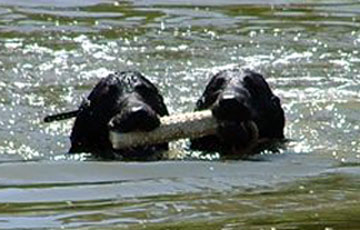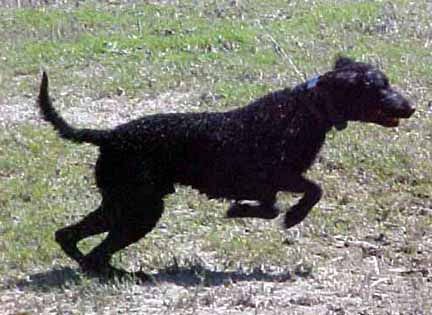

OK, to review what pup has learned so far, he should have a basic understanding of what sit, down, here and walking nice on lead mean. He has been introduced to water, gunfire, dead birds, changes in cover. He has been retrieving his sock bumper in different sorts of cover and out of water up to as far as you can throw. As he gets older, bigger, can see a bit better and is better coordinated, find a helper to throw for you and switch to plastic bumpers once he is old enough to carry one easily.
When you introduce the thrower, you will probably need to have the first two or three marks be close to the pup as he is used to looking to you to throw the bumper, not some weirdo in front of him! Have the thrower make some sort of attractive noise like Hey Hey, or blow a duck call and throw the bumper as soon as the pup is focused on him. Let the pup go as soon as he wants to go for the bumper at this point, until he is sure of how the game is now played, then go back to holding the pup until the bumper has hit the ground. Then begin working on distance gradually, and cover changes gradually but not both at the same time.
At this point several different things can happen. For some reason, some dogs won't fetch plastic.  You can try canvas bumpers, which don't hold up as well and tend to get waterlogged, but if pup will fetch these they are worth the hassle. Other pups won't pick up any sort of bumper but will retrieve birds - I will continue to work pups like this on birds only until they are mature enough for force fetch but training with birds only is not only a hassle and can get expensive, it can also lead to bad habits such as getting sticky or rolling birds. So pups that won't retrieve anything but birds generally get some marks but only enough to keep them interested in the game, until force fetch starts.
You can try canvas bumpers, which don't hold up as well and tend to get waterlogged, but if pup will fetch these they are worth the hassle. Other pups won't pick up any sort of bumper but will retrieve birds - I will continue to work pups like this on birds only until they are mature enough for force fetch but training with birds only is not only a hassle and can get expensive, it can also lead to bad habits such as getting sticky or rolling birds. So pups that won't retrieve anything but birds generally get some marks but only enough to keep them interested in the game, until force fetch starts.
However, many Curly pups will continue to retrieve pretty much anything thrown for them - these pups should have marks thrown for them fairly regularly. Goals should be flexible and depend on the age, coordination, strength and drive of the individual pup, but for all pups remember to always stop while the pup still really, REALLY wants to retrieve. Also be sure to continue to make all training sessions as upbeat as possible, set up all marks to be only slightly harder/longer than what the pup has already been successful at. When working in water, avoid setting up marks that will encourage the pup to run the bank around to a closer entry point, rather than going directly into the water, to avoid creating a bank running problem before pup is really old enough to be taught not to do that.
As the pup becomes more mature mentally and understands the game, he will begin to show this maturity and understanding by calming down a bit on the line. Gradually work on having him sit prior to the bird/bumper being thrown, gradually work on having him remain in a sit as the bird/bumper is thrown, gradually work on him not pulling against the collar before you release him. All this is very slow and is a balancing act between getting a little control and making sure that you are not dampening his enthusiasm for the game.  Once again, at this age you are just shaping and enhancing behaviors he was already born with, not truely training.
Once again, at this age you are just shaping and enhancing behaviors he was already born with, not truely training.
What training pup receives after he is about four-five months old depends on what your goals are. Companion hunters generally don't need much more formal training if they are at least moderately driven to retrieve birds, but will need alot of real life hunting to teach them to ins and outs of hunting for whatever the favorite type of bird is - ducks, geese, pheasant, dove, etc. Those that are mostly interested in showing but would like to get a WC or JH will also not have to do much more formal training, depending on the sort of tests that are average for the area. For example, for awhile in our area it was popular with the judges to set up Junior tests that practically begged the dogs to run the bank and get into trouble that would cause them to not find the bird. So, if something like is happening in your area, you would need to shorebreak your dog. Other times the tests are straight forward and the dogs just need the basic skills of being able to retrieve twice on land up to 100 yards thru one or two changes of cover and twice on water maybe land - water - land but no angle entries or channel swims.
While it is entirely possible to finish working certificate and hunt test titles without force fetch, dogs that don't need it are fairly rare, especially as one gets beyond the JH level. I have finished several WCs and JHs without force fetch (as well as all of Strutter's and Taz's other field titles), but it makes things more difficult for the dog and the trainer. Dogs that develop problems like bank running, not delivering to hand, playing with birds - well, these things can be fixed without force fetch if the dog has good trainability and better than average drive, but even with dogs like that it is easier to fix problems if the dog has been forced, and it's far clearer to the dog if he understands that retrieving is his job, not just something he does how he wants, when he wants.
 To people who don’t do field work, and to many who do, the term “force fetch” is scary and brings up images of abuse and screaming dogs. I’m not going to kid you all, dogs tend to vocalize during this and if it bothers you, DON’T do it! Seriously. Force fetch MUST be taught in a completely unemotional way, without getting upset because the dog is upset. Done correctly, force fetch is not abuse - done incorrectly it can be. If you haven't force fetched a dog, it really should be taught in person the first time.
To people who don’t do field work, and to many who do, the term “force fetch” is scary and brings up images of abuse and screaming dogs. I’m not going to kid you all, dogs tend to vocalize during this and if it bothers you, DON’T do it! Seriously. Force fetch MUST be taught in a completely unemotional way, without getting upset because the dog is upset. Done correctly, force fetch is not abuse - done incorrectly it can be. If you haven't force fetched a dog, it really should be taught in person the first time.
That is about all I feel comfortable talking about in an article! There are so many different directions training can take at any time, depending on the dog, what the trainer is doing, the goals, etc that they really cannot be covered in one article.